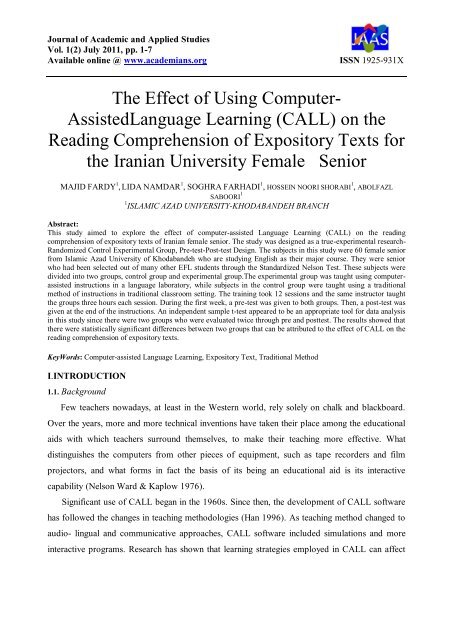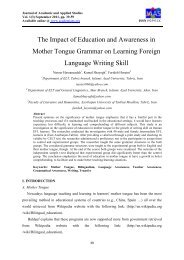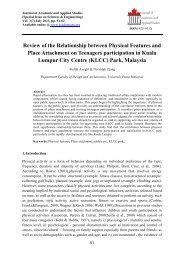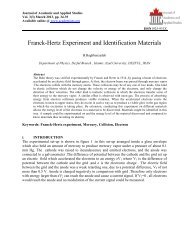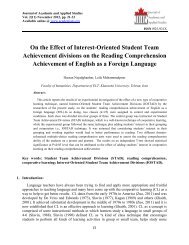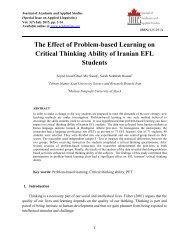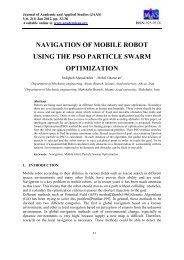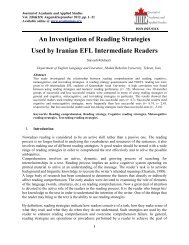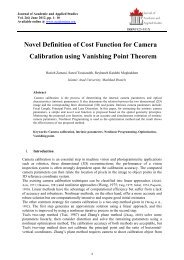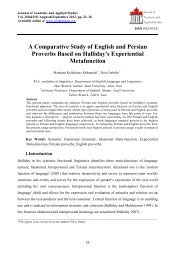(CALL) on the Reading Comprehension of Expository Texts
(CALL) on the Reading Comprehension of Expository Texts
(CALL) on the Reading Comprehension of Expository Texts
- No tags were found...
Create successful ePaper yourself
Turn your PDF publications into a flip-book with our unique Google optimized e-Paper software.
Journal <strong>of</strong> Academic and Applied StudiesVol. 1(2) July 2011, pp. 1-7Available <strong>on</strong>line @ www.academians.org ISSN 1925-931XThe Effect <strong>of</strong> Using Computer-AssistedLanguage Learning (<str<strong>on</strong>g>CALL</str<strong>on</strong>g>) <strong>on</strong> <strong>the</strong><strong>Reading</strong> Comprehensi<strong>on</strong> <strong>of</strong> <strong>Expository</strong> <strong>Texts</strong> for<strong>the</strong> Iranian University Female SeniorMAJID FARDY 1 , LIDA NAMDAR 1 , SOGHRA FARHADI 1 , HOSSEIN NOORI SHORABI 1 , ABOLFAZLSABOORI 11 ISLAMIC AZAD UNIVERSITY-KHODABANDEH BRANCHAbstract:This study aimed to explore <strong>the</strong> effect <strong>of</strong> computer-assisted Language Learning (<str<strong>on</strong>g>CALL</str<strong>on</strong>g>) <strong>on</strong> <strong>the</strong> readingcomprehensi<strong>on</strong> <strong>of</strong> expository texts <strong>of</strong> Iranian female senior. The study was designed as a true-experimental research-Randomized C<strong>on</strong>trol Experimental Group, Pre-test-Post-test Design. The subjects in this study were 60 female seniorfrom Islamic Azad University <strong>of</strong> Khodabandeh who are studying English as <strong>the</strong>ir major course. They were seniorwho had been selected out <strong>of</strong> many o<strong>the</strong>r EFL students through <strong>the</strong> Standardized Nels<strong>on</strong> Test. These subjects weredivided into two groups, c<strong>on</strong>trol group and experimental group.The experimental group was taught using computerassistedinstructi<strong>on</strong>s in a language laboratory, while subjects in <strong>the</strong> c<strong>on</strong>trol group were taught using a traditi<strong>on</strong>almethod <strong>of</strong> instructi<strong>on</strong>s in traditi<strong>on</strong>al classroom setting. The training took 12 sessi<strong>on</strong>s and <strong>the</strong> same instructor taught<strong>the</strong> groups three hours each sessi<strong>on</strong>. During <strong>the</strong> first week, a pre-test was given to both groups. Then, a post-test wasgiven at <strong>the</strong> end <strong>of</strong> <strong>the</strong> instructi<strong>on</strong>s. An independent sample t-test appeared to be an appropriate tool for data analysisin this study since <strong>the</strong>re were two groups who were evaluated twice through pre and posttest. The results showed that<strong>the</strong>re were statistically significant differences between two groups that can be attributed to <strong>the</strong> effect <strong>of</strong> <str<strong>on</strong>g>CALL</str<strong>on</strong>g> <strong>on</strong> <strong>the</strong>reading comprehensi<strong>on</strong> <strong>of</strong> expository texts.KeyWords: Computer-assisted Language Learning, <strong>Expository</strong> Text, Traditi<strong>on</strong>al MethodI.INTRODUCTION1.1. BackgroundFew teachers nowadays, at least in <strong>the</strong> Western world, rely solely <strong>on</strong> chalk and blackboard.Over <strong>the</strong> years, more and more technical inventi<strong>on</strong>s have taken <strong>the</strong>ir place am<strong>on</strong>g <strong>the</strong> educati<strong>on</strong>alaids with which teachers surround <strong>the</strong>mselves, to make <strong>the</strong>ir teaching more effective. Whatdistinguishes <strong>the</strong> computers from o<strong>the</strong>r pieces <strong>of</strong> equipment, such as tape recorders and filmprojectors, and what forms in fact <strong>the</strong> basis <strong>of</strong> its being an educati<strong>on</strong>al aid is its interactivecapability (Nels<strong>on</strong> Ward & Kaplow 1976).Significant use <strong>of</strong> <str<strong>on</strong>g>CALL</str<strong>on</strong>g> began in <strong>the</strong> 1960s. Since <strong>the</strong>n, <strong>the</strong> development <strong>of</strong> <str<strong>on</strong>g>CALL</str<strong>on</strong>g> s<strong>of</strong>twarehas followed <strong>the</strong> changes in teaching methodologies (Han 1996). As teaching method changed toaudio- lingual and communicative approaches, <str<strong>on</strong>g>CALL</str<strong>on</strong>g> s<strong>of</strong>tware included simulati<strong>on</strong>s and moreinteractive programs. Research has shown that learning strategies employed in <str<strong>on</strong>g>CALL</str<strong>on</strong>g> can affect
Journal <strong>of</strong> Academic and Applied StudiesVol. 1(2) July 2011, pp. 1-7Available <strong>on</strong>line @ www.academians.org ISSN 1925-931X<strong>the</strong> quality <strong>of</strong> learning <strong>the</strong> language. However, it still lacks methods and a clear <strong>the</strong>oreticalfoundati<strong>on</strong> (Christopher 1995).The idea <strong>of</strong> using computers for teaching purposes in subjects like modern languages arousesmixed feeling and meets with a variety <strong>of</strong> reacti<strong>on</strong>s (Kenning & Kenning 1983). The fact thatcomputers are used in <strong>the</strong> teaching <strong>of</strong> o<strong>the</strong>r subjects and are put to a great many applicati<strong>on</strong>s insociety makes <strong>on</strong>e suspect that no field lays completely outside <strong>the</strong>ir scope and that <strong>the</strong>y mightindeed be <strong>of</strong> some use (Davies & Higgins 1980). To many, <strong>the</strong> prospect <strong>of</strong> using computers is notwithout appeal; it is <strong>the</strong> kind <strong>of</strong> challenge which <strong>on</strong>e feels drawn to resp<strong>on</strong>d to. At <strong>the</strong> same time,<strong>the</strong> technology frightens us; we are afraid that it may come to dominate us and we may be evenbeing afraid <strong>of</strong> losing our jobs.Kulik and Kulik(1991) surveyed more than 500 studies which compared learners whoreceived computer-assisted instructi<strong>on</strong> with <strong>the</strong> learners who received traditi<strong>on</strong>al instructi<strong>on</strong>.They found that learners tend to learn more and in less time with computer-assisted learning.There are two questi<strong>on</strong>s that this research is going to answer:- Is <strong>the</strong>re a statistically significant difference c<strong>on</strong>cerning <strong>the</strong> gain scores <strong>on</strong> <strong>the</strong> readingcomprehensi<strong>on</strong> <strong>of</strong> expository texts between <strong>the</strong> learners instructed by <strong>the</strong> <str<strong>on</strong>g>CALL</str<strong>on</strong>g> and <strong>the</strong>learners instructed by <strong>the</strong> traditi<strong>on</strong>al approach?- What do <strong>the</strong> language learners in <strong>the</strong> experimental group think about <strong>the</strong> <str<strong>on</strong>g>CALL</str<strong>on</strong>g> as tolearn?II. METHODOLOGY2.1. SubjectsThe students in this study were sixty university female senior in Khodabandeh Islamic Azaduniversity (educati<strong>on</strong>al year 2011) studying English as a foreign Language, with ages between22and 26. They were Iranian students. They c<strong>on</strong>sented to participate in this study and weremotivated by being informed in advance that <strong>the</strong>y would receive extra credit for <strong>the</strong>irparticipati<strong>on</strong>.2
Journal <strong>of</strong> Academic and Applied StudiesVol. 1(2) July 2011, pp. 1-7Available <strong>on</strong>line @ www.academians.org ISSN 1925-931XTABLE IRANDOMIZED CONTROL EXPERIMENTAL GROUP, PRE-TEST POST-TEST DESIGNGroup Pre-test Independent variable Post-testA T1 X T2B T1 - T2In this design T1 (A) and T1 (B) are <strong>the</strong> tests before applying <strong>the</strong> treatment, and T2 (A) , T2 (B)are <strong>the</strong> tests after treatment, respectively, where X is <strong>the</strong> treatment. Based <strong>on</strong> <strong>the</strong> design <strong>the</strong>difference between <strong>the</strong> mean <strong>of</strong> <strong>the</strong> pretest and posttest <strong>of</strong> <strong>the</strong> first group scores and <strong>the</strong> differencebetween <strong>the</strong> mean <strong>of</strong> <strong>the</strong> pretest and posttest for <strong>the</strong> next group scores are tested for <strong>the</strong> statisticalsignificance. At <strong>the</strong> outset <strong>of</strong> <strong>the</strong> study two groups were given a pre-test described in <strong>the</strong>instrument secti<strong>on</strong>s; <strong>the</strong> test involved 50 items about reading comprehensi<strong>on</strong>. To ensure <strong>the</strong> testswere delivered in an identical fashi<strong>on</strong>, <strong>the</strong> researcher administered <strong>the</strong> test for each group, giving<strong>the</strong> same instructi<strong>on</strong> in each case. The researcher administered <strong>the</strong> pretest to both groups in <strong>the</strong>same class and recorded <strong>the</strong> scores, <strong>the</strong>n both groups received instructi<strong>on</strong> through different mediafor twelve weeks and three hours each week by <strong>the</strong> same instructor. During <strong>the</strong> twelve weeks, forclassroom practice, TOEFL (2002) were used. The learners instructed by <strong>the</strong> <str<strong>on</strong>g>CALL</str<strong>on</strong>g> also used <strong>the</strong>CD versi<strong>on</strong>s <strong>of</strong> <strong>the</strong>se materials.2.4. ProcedureThe subjects in <strong>the</strong> experimental group (30 female subjects) worked al<strong>on</strong>e <strong>on</strong> a computer andlearned at <strong>the</strong>ir will (all <strong>the</strong> subjects in <strong>the</strong> experimental group knew how to use computer). Theystudied any secti<strong>on</strong> as much as <strong>the</strong>y liked.The researcher did not participate in <strong>the</strong> teaching/learning process, but <strong>the</strong> researcherm<strong>on</strong>itored <strong>the</strong> class just to make sure that subjects were working with <strong>the</strong> computer and to help ifanything went wr<strong>on</strong>g with <strong>the</strong> computers.The subjects in <strong>the</strong> c<strong>on</strong>trol group (30 female subjects) met <strong>the</strong> researcher three hours eachsessi<strong>on</strong> during twelve weeks. The same materials (printed and paper versi<strong>on</strong> <strong>of</strong> <strong>the</strong> practice tests)were used according to <strong>the</strong> schedule set by <strong>the</strong> researcher. Subjects studied readingcomprehensi<strong>on</strong> during three hours. On <strong>the</strong> last day <strong>of</strong> classes, <strong>the</strong> researcher administered <strong>the</strong>posttest. The scores obtained by <strong>the</strong> pretest and posttest were statistically analyzed.2.5. Data Analysis4


